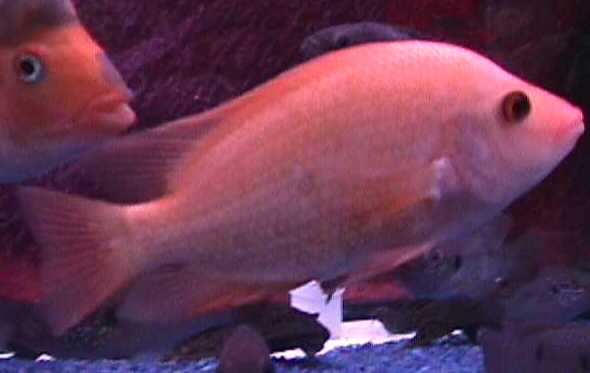Cichlid - Red Devil
Scientific Name: Cichlasoma amphilophus labiatum
Fri, 11th April, 2025 - 11:19 pm GMT
Sponsor Ads:

Alternative Name
Scientific Name: Cichlasoma amphilophus labiatumBasic Info
The Red Devil Cichlid can reach a size of roughly 12 inches. Red Devil Cichlids have varying color patterns, which include orange, yellow, red, white and black. Surprisingly the red color is relatively rare in the wild. Their color patterns include six dark colored bars along their sides, and a large black spot on their mid-side. Red Devil Cichlids have a hump on their head, and the male's hump will be larger than the female's, which distinguishes the two sexes. Contrary to some reports, the Red Devil Cichlid (Cichlasoma Amphilophus Labiatum) is a different subspecies than the Midas Cichlid (Cichlasoma Amphilophus Citrinellum). These subspecies are often confused and an easy way to differentiate them is to examine their mouths. The mouth of the Midas Cichlid is wider than that of the Red Devil.
Health
Besides watching it for destructive behavior, the Red Devil Cichlid is fairly easy to care for. They should be kept in slightly acidic to neutral waters, with pH levels from 6.8 to 7.2. They will thrive in waters with a temperature range from 73 to 82 degrees fahrenheit. Rock salt (not iodized) should be added to a new tank set up at about 8 ounces per 25-gallons of water. Be sure to add the salt back after a partial water change. This will keep your fish healthy and may minimize occurrences of diseases such as ick as well as incidence of parasitic infection. They can be fed vegetables, including spinach, zucchini, peas, and lettuce as well as live foods, including small live fish, blood worms, glass worms, brine shrimp, and tubifex worms. Frozen, freeze dried and tablet foods will also be accepted. Breeding Red Devil Cichlids can be difficult to breed. The Red Devil Cichlid will lay their eggs in a dark hidden place, and will care for the eggs and fry. However, Red Devil Cichlids become extremely aggressive during spawning, and other fish should be removed from the tank.Habitat
Fresh water fishBehavior
The Red Devil Cichlid makes a great and colorful addition to large fish tanks and Cichlid tanks. Many people consider the Red Devil Cichlid to be the most interesting and beautiful Cichlid around. While beautiful, the Red Devil Cichlid is an aggressive and territorial fish. This fish will bite the hand that feeds it - literally. Some Red Devils are able to get along with other comparably sized cichlids, but most will normally become more aggressive when breeding. There aren't any certain fish that the Red Devil Cichlid will be able to live with; usually this can only be determined by trial and error. Many have reported their Red Devil Cichlids living peacefully with other fish, but often times these fish were introduced to the others at an early age. Others have reported that Red Devils cannot live with any other fish. Keeping them well fed is a good way to help prevent them from trying to eat tank mates. Red Devil Cichlids should be kept in large tanks with plenty of hiding places. This includes moderate rock and decorative plants, as Red Devil Cichlids will kill any live plants. Additionally they tend to destroy decorations in tanks, and this should be kept in mind before purchase. Red Devils are incredible digger/nest builders; they can level your carefully decorated tank in just a few hours. They pick up mouthfuls of gravel and blast it against the glass, giving the bottom a dished up effect. Some hobbyists will tie down plastic plants in an effort to keep a tank decorated.Origin
South AmericaHistory
The Red Devil Cichlid is originally from the Central American countries of Nicaragua, Panama, and El Salvador, and in Florida.Common Foods
N/ASponsor Ads:
Thoughts on Programming, Number 18: The human mind ordinarily operates at only ten per cent of its capacity - the rest is overhead for the operating system. -Anonymous
Cichlid - Red Devil
Coded by: BGID® | ALL RIGHTS RESERVED Copyright © 2000-2025
Disclaimer | Privacy | Report Errors / Contact | Credits








 President of the United States of America - Real Estate mogul, Pageant owner and now one of the most controversial men in political history.
President of the United States of America - Real Estate mogul, Pageant owner and now one of the most controversial men in political history.  Politician, US Vice President and President of the USA - Joseph Robinette Biden Jr.
Politician, US Vice President and President of the USA - Joseph Robinette Biden Jr.  versus
versus  Russia: 'The Evil Empire'? Are they all that bad or is it just the USA trying to portray Russia as bad because they are a world power with land bigger and a society very different from the USA ideal?
Russia: 'The Evil Empire'? Are they all that bad or is it just the USA trying to portray Russia as bad because they are a world power with land bigger and a society very different from the USA ideal?  Global warming has been in and out as the "latest" hot topic for many years. It is, according to modern scientists, the result of man-made industrial pollutants, clearing forested areas, agriculture, etc. But now they are thinking it started way before the Industrial Revolution...
Global warming has been in and out as the "latest" hot topic for many years. It is, according to modern scientists, the result of man-made industrial pollutants, clearing forested areas, agriculture, etc. But now they are thinking it started way before the Industrial Revolution... 
 Corona virus
Corona virus 
 Users with wide screen monitors can benefit from more content on every page.
Users with wide screen monitors can benefit from more content on every page.